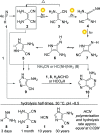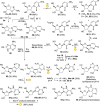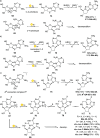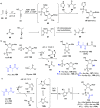Illuminating Life's Origins: UV Photochemistry in Abiotic Synthesis of Biomolecules
- PMID: 33880920
- PMCID: PMC8240947
- DOI: 10.1021/jacs.1c01839
Illuminating Life's Origins: UV Photochemistry in Abiotic Synthesis of Biomolecules
Abstract
Solar radiation is the principal source of energy available to Earth and has unmatched potential for the synthesis of organic material from primordial molecular building blocks. As well as providing the energy for photochemical synthesis of (proto)biomolecules of interest in origins of life-related research, light has also been found to often provide remarkable selectivity in these processes, for molecules that function in extant biology and against those that do not. As such, light is heavily implicated as an environmental input on the nascent Earth that was important for the emergence of complex yet selective chemical systems underpinning life. Reactivity and selectivity in photochemical prebiotic synthesis are discussed, as are their implications for origins of life scenarios and their plausibility, and the future directions of this research.
Conflict of interest statement
The authors declare no competing financial interest.
Figures











Similar articles
-
Mimicking the surface and prebiotic chemistry of early Earth using flow chemistry.Nat Commun. 2018 May 8;9(1):1821. doi: 10.1038/s41467-018-04147-2. Nat Commun. 2018. PMID: 29739945 Free PMC article.
-
Prebiotic chemical refugia: multifaceted scenario for the formation of biomolecules in primitive Earth.Theory Biosci. 2022 Nov;141(4):339-347. doi: 10.1007/s12064-022-00377-7. Epub 2022 Aug 30. Theory Biosci. 2022. PMID: 36042123 Review.
-
Life's Biological Chemistry: A Destiny or Destination Starting from Prebiotic Chemistry?Chemistry. 2018 Nov 13;24(63):16708-16715. doi: 10.1002/chem.201801847. Epub 2018 Aug 13. Chemistry. 2018. PMID: 29870593 Review.
-
Timescales for Prebiotic Photochemistry Under Realistic Surface Ultraviolet Conditions.Astrobiology. 2021 Sep;21(9):1099-1120. doi: 10.1089/ast.2020.2335. Epub 2021 Jun 21. Astrobiology. 2021. PMID: 34152196 Free PMC article.
-
UV Transmission in Natural Waters on Prebiotic Earth.Astrobiology. 2022 Mar;22(3):242-262. doi: 10.1089/ast.2020.2422. Epub 2021 Dec 16. Astrobiology. 2022. PMID: 34939825 Free PMC article.
Cited by
-
On the Origin of Sugar Handedness: Facts, Hypotheses and Missing Links-A Review.Orig Life Evol Biosph. 2022 Sep;52(1-3):21-56. doi: 10.1007/s11084-022-09624-9. Epub 2022 Jul 7. Orig Life Evol Biosph. 2022. PMID: 35796896 Review.
-
Prebiotic Synthesis of ATP: A Terrestrial Volcanism-Dependent Pathway.Life (Basel). 2023 Mar 8;13(3):731. doi: 10.3390/life13030731. Life (Basel). 2023. PMID: 36983886 Free PMC article.
-
Photoinduced charge separation and DNA self-repair depend on sequence directionality and stacking pattern.Chem Sci. 2023 Dec 28;15(6):2158-2166. doi: 10.1039/d3sc04971j. eCollection 2024 Feb 7. Chem Sci. 2023. PMID: 38332835 Free PMC article.
-
Purine Chemistry in the Early RNA World at the Origins of Life: From RNA and Nucleobases Lesions to Current Key Metabolic Routes.Chembiochem. 2025 Jun 3;26(11):e202500035. doi: 10.1002/cbic.202500035. Epub 2025 Apr 16. Chembiochem. 2025. PMID: 40237374 Free PMC article. Review.
-
Prebiotic photoredox synthesis from carbon dioxide and sulfite.Nat Chem. 2021 Nov;13(11):1126-1132. doi: 10.1038/s41557-021-00789-w. Epub 2021 Oct 11. Nat Chem. 2021. PMID: 34635812 Free PMC article.
References
-
- Sutherland J. D. Opinion: Studies on the Origin of Life — the End of the Beginning. Nat. Rev. Chem. 2017, 1 (2), 0012.10.1038/s41570-016-0012. - DOI
Publication types
MeSH terms
Substances
Grants and funding
LinkOut - more resources
Full Text Sources
Other Literature Sources
Research Materials

